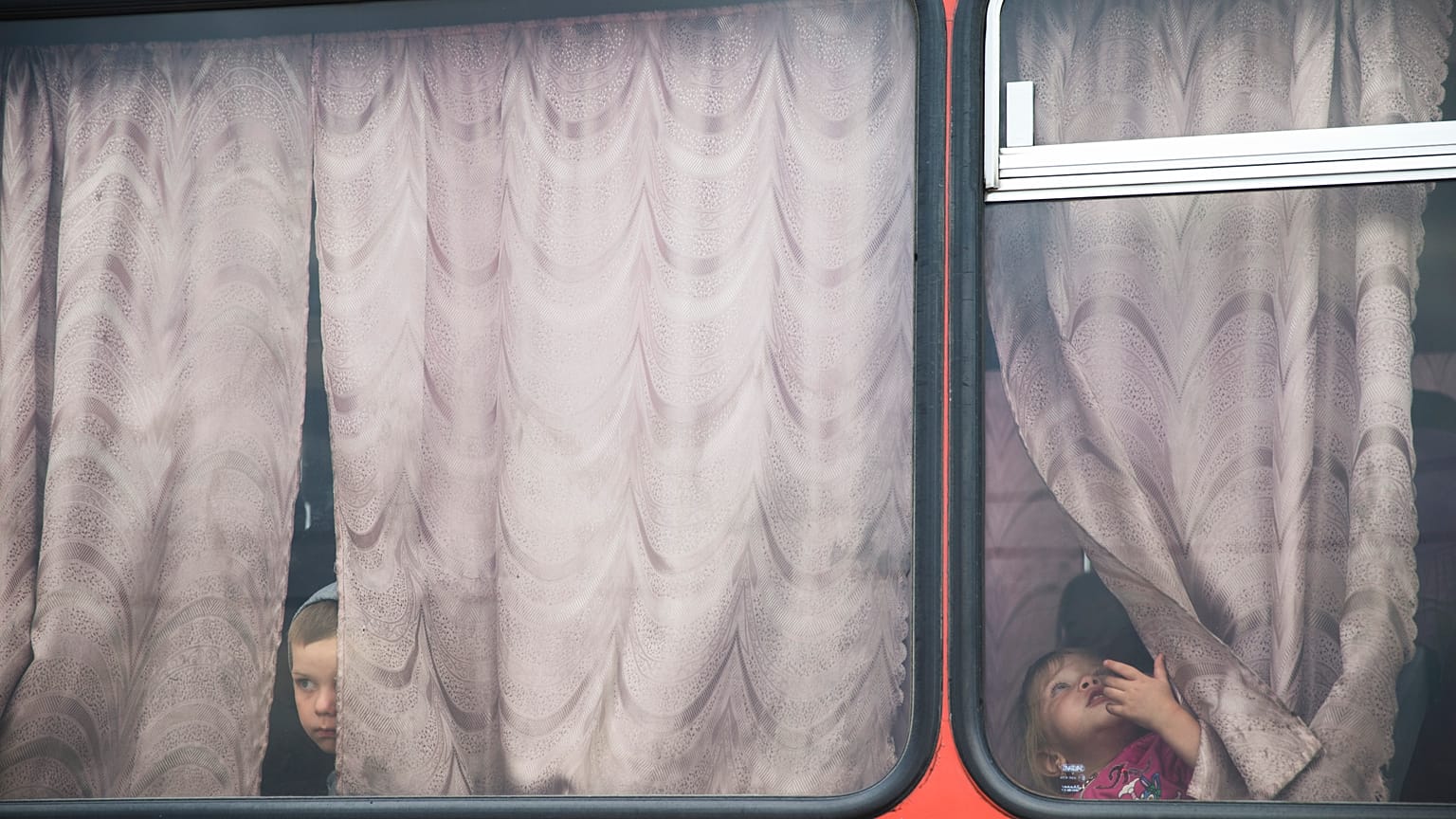Thousands of Ukrainian children are being forced into a system designed to turn them into Russians.
Thousands of Ukrainian children are being forced into a system designed to turn them into Russians, a process Moscow appears to have kicked into high gear shortly after launching its full-scale invasion last year.
Russia has been using various tactics to move Ukrainian kids onto territory under its control.
Children living in institutionalised care are deported under the guise of evacuation, while others are separated from their families in filtration camps. In many cases, families send their children to camps on occupied territory to take refuge from the war—then communication is cut off, and they disappear.
Artificial intelligence is being deployed to find children and the facilities holding them, hotlines connect reports to police, and family members have been crossing into Russia to physically bring kids back.
But most children end up in ‘re-education camps,’ illegally adopted into Russian families or lost.
The forced deportation and naturalisation of Ukrainian children by Russia has been described as a war crime by UN investigators and prompted the International Criminal Court to issue arrest warrants last week against president Vladimir Putin and Maria Lvova-Belova, the country's Commissioner for Children's Rights.
'It has to be the guardian that undertakes this journey'
Lyudmila Motychak is one of the parents that crossed into occupied territory to find her child.
In November, she got on a ferry to Russian-occupied Crimea, crossing over from Kherson to get her then 15-year-old daughter, Anastasia, back. Time was running out.
One month earlier, the director of Anastasia’s university convinced Motychak to send her daughter to a wellness centre in Crimea, where she could rest and seek refuge from the war. She was skeptical, but “the director was very convincing,” and Motychak eventually obliged after seeing other students safely go and return.
Things didn’t go as planned.
“First, they said the students wouldn’t stay more than two weeks,” Motychak told Euronews. “Then, they began to put off the date… they said, ‘don’t worry, they’ll be back at the end of October, then November… then even later.”
The director then told Motychak she’d have to pick up Anastasia personally. Shortly after Ukrainian forces took back Kherson, all contact between the mother and director was cut. In retrospect, she thinks the director was working with Russia, and fled when control changed hands.
Motychak was scared, keeping in touch with Anastasia through Telegram.
She contacted organisations for help. Meanwhile, Anastasia had been moved to a hospital after contracting chicken pox which Motychak thinks saved Anastasia from being sent to Russia. Eventually, the mother and daughter were reunited.
“Our understanding… is that [the children] need to be physically accompanied by someone that has permission to take them,” Laura Mills, Crisis Response Researcher at Amnesty International, said over the phone. “As far as we know it has to be the guardian that undertakes this journey.”
Traveling up to thousands of kilometres—and ultimately into what’s perceived as enemy territory—is dangerous, expensive and risky. But the first roadblock is often knowing where to look.
“We’re advocating for there to be some kind of family tracing system… the burden shouldn’t be on guardians in Ukraine to organise the entire journey themselves,” Mills continued. “Also, I didn’t mention that they then have to find the children themselves.”
'Name changes, new passports, illegal adoptions'
The 116000 hotline, NGO Magnolia, Save Ukraine, the Children of War website portal and others are all working with local authorities to report and track missing children. But there are limitations to what they can accomplish from the outside.
“It’s often through volunteers or other people that know the whereabouts of this [missing] person and then help them get in touch,” Mills explained. “It’s not organised by the Russian state or child protective services… ideally, you’d have government-to-government contact where they say ‘ok, here are all the children who crossed into Russia during this time,’ and give all of the information they have… but that sort of exchange of information is not happening.”
Russia is framing adoptions as acts of benevolence and dispersing videos of Ukrainian children in re-education camps through social media channels. The kids are often shown singing the Russian national anthem or carrying its flag.
“Name changes, new passports, illegal adoptions... they’re marketing this and really using it as propaganda, [saying] they’re saving these children and giving them a life in Russia,” Aagje Ieven, Secretary General of Missing Children Europe, said over the phone.
'This is a complex logistical system that has some militarised element'
Ironically, the propaganda Russia spreads is being used to map out where these children are.
Yale University and the Conflict Observatory programme of the US State Department released an extensive report largely drawing from open-source material like social media posts, photographs, and publications released by Russian government officials themselves.
“We [translated] everything local officials were saying about their transfers… they were doing it publicly,” Nathaniel Raymond, Executive Director of the Yale Humanitarian Research Lab, said over the phone.
The research pinpointed 43 centres stretching out to Siberia and Magadan.
“We think the number of facilities is significantly higher than 43… this is a complex logistical system that has some militarised element,” Raymond added. “It’s dispersed, diverse and extremely large in its geographic scope.”
'Plans of turning Ukrainian children into Russian children'
Normally, there is a moratorium put on adoptions during times of war in order to track down and reconnect family members.
But so-called re-education camps started cropping up in 2014, following Russia's annexation of the Crimean peninsula — a move deemed illegal by the international community.
Then last spring, the country loosened its adoption and nationality rules to make it easier for Russian nationals to adopt Ukrainian children without parental care, and give them citizenship, signalling a possible acceleration in its policy.
Missing Children Europe also noticed shortly after that the school curricula in occupied territory were being switched to the Russian curriculum.
“All of those different things started pointing to plans of turning Ukrainian children into Russian children,” Ieven said.
Forcible adoptions risk impeding the possibility to return to Ukraine—both now and in the long term.
“They’ll have their national identity stripped from them, and that is very clearly a violation of international law,” Mills said. “The adoption bills that have been passed on the Russian side to facilitate citizenship and adoption into Russian families… there’s a huge risk that [the children] will disappear without a trace into Russian society.”
The impact could be permanent.
“It's a way of stealing a generation,” Ieven said. “If you can’t conquer them, you make them Russian.”
The interview with Lyudmila and Anastasia Motychak was interpreted by Salvatore Del Gaudio, Professor of Slavic Philology and Linguistics at the University of Salerno, over Zoom.
















